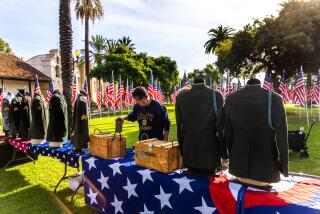VENTURA : Family Trees in Full Bloom for Balboa Students
- Share via
There were a lot of things Jared Fisher never knew about his ancestors when he started researching his Ventura family’s history.
For instance, the Balboa Middle School eighth-grader learned that his great-grandfather, Milburn Johnson, served on a ship that wrecked during World War II and never really recovered from the trauma of drifting on the ocean for eight days without food.
He found that a great-grandmother lost her sight and hearing on one side due to an early childhood bout with scarlet fever. She was also part Blackfoot Indian, Jared discovered.
“I wasn’t too excited when we started this project,” said the 14-year-old. “But now I think it’s pretty neat.”
Jared is one of 250 eighth-grade students at Balboa who took part in the school’s Family History Night. The event, held Thursday in the school cafeteria, was so popular that squeezing past exhibits chock full of family artifacts, records, photographs and genealogy charts took some effort.
The night has been an annual tradition at Balboa for two decades, part of the students’ study of American history, said Principal Helena Torres-Reaves.
Students are asked to construct a family tree as far back as they can go, to interview two ancestors who are at least 65 years old and to build an exhibit featuring the family memorabilia, Reaves said.
“What we are trying to do is tie history to their families so it becomes more personal,” she said. “It gets them talking about their families, and there is a lot of pride involved.”
The exhibits ranged from yellowed newspaper clippings about some long-dead relative to highly personal mementos. Chris Ohlsen displayed a wooden crucifix that he said was used to administer the last rites to his maternal great-grandmother.
Tommy Mercer wore his father’s cadet uniform from a military academy in San Diego.
And Leanna Rodriguez included a photograph of her bare-chested father holding an Army-issued M-14 rifle during his deployment to Vietnam.
Not all of the students’ findings were pleasant. After flipping through a genealogical record that included 74 pages of ancestors, Scott Kingsland discovered that a distant uncle once owned slaves on his New Jersey plantation.
“I was really shocked,” Scott said.
Large maps on the cafeteria walls traced the migration patterns of some students’ family. And several students had artifacts from other nations, such as Mexico, Holland and Germany.
More to Read
Sign up for Essential California
The most important California stories and recommendations in your inbox every morning.
You may occasionally receive promotional content from the Los Angeles Times.














